18 items found
Page 1 of 1
-
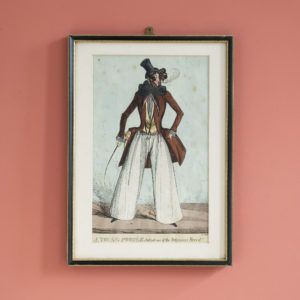
‘A Young Poodle, but not one of the Sagacious Breed’
£520‘A Young Poodle, but not one of the Sagacious Breed’
Caricaturist, presumably of Irish background, but undocumented. Responsible for a small number of plates in a distinctive hand. Unclear whether he etched them all or only designed them. Never a publisher. Worked for P.Roberts and J.Aitken. Many unsigned prints by both men may well be by him.£520 -
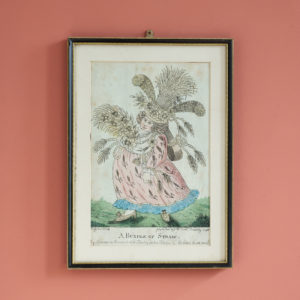
A Bundle of Straw, My Spouse is Remarkable Tasty in his Dress & he likes to see me so.
£520A Bundle of Straw, My Spouse is Remarkable Tasty in his Dress & he likes to see me so.
Caricaturist, presumably of Irish background, but undocumented. Responsible for a small number of plates in a distinctive hand. Unclear whether he etched them all or only designed them. Never a publisher. Worked for P.Roberts and J.Aitken. Many unsigned prints by both men may well be by him.£520 -
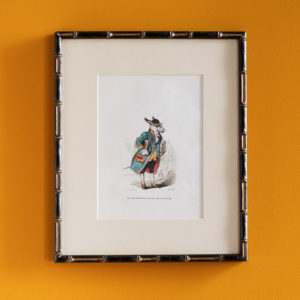
Public and Private Life of Animals, by J. J. Grandville, ‘Les savants envoyèrent un académicien…’,
£220 eachPublic and Private Life of Animals, by J. J. Grandville, ‘Les savants envoyèrent un académicien…’,
First published in France, these prints are based on the drawings of the famed caricaturist J. J. Grandville. Born Jean Ignace Isidore Gérard, Gradville; he fought on the barricades during the revolution of 1830 which dethroned Charles X, the last Bourban king. It was during this period that his cartoons appeared in two of the most famous satirical journals of the time; Le Charivari and Le Caricature, but in 1835 these publications were suppressed by the government of Louis-Philippe. This event extinguished his income and means of political expression and forced him to start making a living by book illustration. The ‘Public and Private Life of Animals’ allowed him to criticise society and its effect on individuals through one of the oldest narrative types; the animal fable. His caricaturist’s skills combined the human and animal characteristics giving him a vehicle of expression as to what was not permissible in ‘Society’ but was perfectly acceptable when the material was presented as humorous or satirical.£220 each -
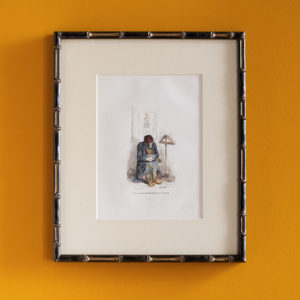
Public and Private Life of Animals, by J. J. Grandville, ‘un rat d’église’,
£220 eachPublic and Private Life of Animals, by J. J. Grandville, ‘un rat d’église’,
First published in France, these prints are based on the drawings of the famed caricaturist J. J. Grandville. Born Jean Ignace Isidore Gérard, Gradville; he fought on the barricades during the revolution of 1830 which dethroned Charles X, the last Bourban king. It was during this period that his cartoons appeared in two of the most famous satirical journals of the time; Le Charivari and Le Caricature, but in 1835 these publications were suppressed by the government of Louis-Philippe. This event extinguished his income and means of political expression and forced him to start making a living by book illustration. The ‘Public and Private Life of Animals’ allowed him to criticise society and its effect on individuals through one of the oldest narrative types; the animal fable. His caricaturist’s skills combined the human and animal characteristics giving him a vehicle of expression as to what was not permissible in ‘Society’ but was perfectly acceptable when the material was presented as humorous or satirical.£220 each -
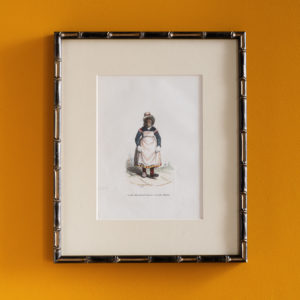
Public and Private Life of Animals, by J. J. Grandville, ‘la plus jolie villageoise’,
£220 eachPublic and Private Life of Animals, by J. J. Grandville, ‘la plus jolie villageoise’,
First published in France, these prints are based on the drawings of the famed caricaturist J. J. Grandville. Born Jean Ignace Isidore Gérard, Gradville; he fought on the barricades during the revolution of 1830 which dethroned Charles X, the last Bourban king. It was during this period that his cartoons appeared in two of the most famous satirical journals of the time; Le Charivari and Le Caricature, but in 1835 these publications were suppressed by the government of Louis-Philippe. This event extinguished his income and means of political expression and forced him to start making a living by book illustration. The ‘Public and Private Life of Animals’ allowed him to criticise society and its effect on individuals through one of the oldest narrative types; the animal fable. His caricaturist’s skills combined the human and animal characteristics giving him a vehicle of expression as to what was not permissible in ‘Society’ but was perfectly acceptable when the material was presented as humorous or satirical.£220 each -
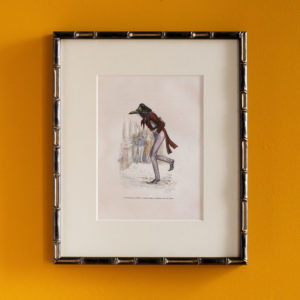
Public and Private Life of Animals, by J. J. Grandville, ‘Les études sont pénibles…’,
£220 eachPublic and Private Life of Animals, by J. J. Grandville, ‘Les études sont pénibles…’,
First published in France, these prints are based on the drawings of the famed caricaturist J. J. Grandville. Born Jean Ignace Isidore Gérard, Gradville; he fought on the barricades during the revolution of 1830 which dethroned Charles X, the last Bourban king. It was during this period that his cartoons appeared in two of the most famous satirical journals of the time; Le Charivari and Le Caricature, but in 1835 these publications were suppressed by the government of Louis-Philippe. This event extinguished his income and means of political expression and forced him to start making a living by book illustration. The ‘Public and Private Life of Animals’ allowed him to criticise society and its effect on individuals through one of the oldest narrative types; the animal fable. His caricaturist’s skills combined the human and animal characteristics giving him a vehicle of expression as to what was not permissible in ‘Society’ but was perfectly acceptable when the material was presented as humorous or satirical.£220 each -
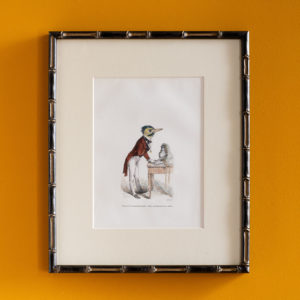
Public and Private Life of Animals, by J. J. Grandville, ‘Grand savant’,
£220 eachPublic and Private Life of Animals, by J. J. Grandville, ‘Grand savant’,
First published in France, these prints are based on the drawings of the famed caricaturist J. J. Grandville. Born Jean Ignace Isidore Gérard, Gradville; he fought on the barricades during the revolution of 1830 which dethroned Charles X, the last Bourban king. It was during this period that his cartoons appeared in two of the most famous satirical journals of the time; Le Charivari and Le Caricature, but in 1835 these publications were suppressed by the government of Louis-Philippe. This event extinguished his income and means of political expression and forced him to start making a living by book illustration. The ‘Public and Private Life of Animals’ allowed him to criticise society and its effect on individuals through one of the oldest narrative types; the animal fable. His caricaturist’s skills combined the human and animal characteristics giving him a vehicle of expression as to what was not permissible in ‘Society’ but was perfectly acceptable when the material was presented as humorous or satirical.£220 each -
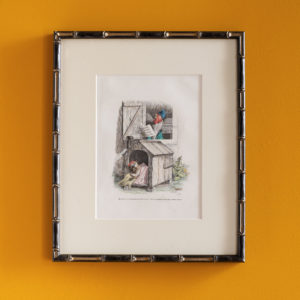
Public and Private Life of Animals, by J. J. Grandville, ‘Quand on ne tient pas à voir lever l’aurore…’,
£220 eachPublic and Private Life of Animals, by J. J. Grandville, ‘Quand on ne tient pas à voir lever l’aurore…’,
First published in France, these prints are based on the drawings of the famed caricaturist J. J. Grandville. Born Jean Ignace Isidore Gérard, Gradville; he fought on the barricades during the revolution of 1830 which dethroned Charles X, the last Bourban king. It was during this period that his cartoons appeared in two of the most famous satirical journals of the time; Le Charivari and Le Caricature, but in 1835 these publications were suppressed by the government of Louis-Philippe. This event extinguished his income and means of political expression and forced him to start making a living by book illustration. The ‘Public and Private Life of Animals’ allowed him to criticise society and its effect on individuals through one of the oldest narrative types; the animal fable. His caricaturist’s skills combined the human and animal characteristics giving him a vehicle of expression as to what was not permissible in ‘Society’ but was perfectly acceptable when the material was presented as humorous or satirical.£220 each -
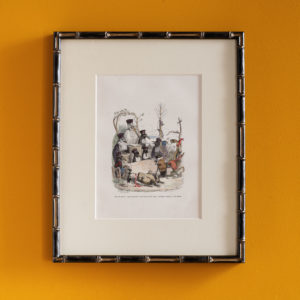
Public and Private Life of Animals, by J. J. Grandville, ‘L’unfortuné crapaud’,
£220 eachPublic and Private Life of Animals, by J. J. Grandville, ‘L’unfortuné crapaud’,
First published in France, these prints are based on the drawings of the famed caricaturist J. J. Grandville. Born Jean Ignace Isidore Gérard, Gradville; he fought on the barricades during the revolution of 1830 which dethroned Charles X, the last Bourban king. It was during this period that his cartoons appeared in two of the most famous satirical journals of the time; Le Charivari and Le Caricature, but in 1835 these publications were suppressed by the government of Louis-Philippe. This event extinguished his income and means of political expression and forced him to start making a living by book illustration. The ‘Public and Private Life of Animals’ allowed him to criticise society and its effect on individuals through one of the oldest narrative types; the animal fable. His caricaturist’s skills combined the human and animal characteristics giving him a vehicle of expression as to what was not permissible in ‘Society’ but was perfectly acceptable when the material was presented as humorous or satirical.£220 each -
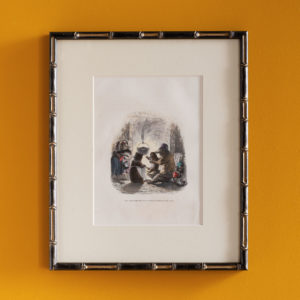
Public and Private Life of Animals, by J. J. Grandville, ‘Nous vivons entre nous’,
£220 eachPublic and Private Life of Animals, by J. J. Grandville, ‘Nous vivons entre nous’,
First published in France, these prints are based on the drawings of the famed caricaturist J. J. Grandville. Born Jean Ignace Isidore Gérard, Gradville; he fought on the barricades during the revolution of 1830 which dethroned Charles X, the last Bourban king. It was during this period that his cartoons appeared in two of the most famous satirical journals of the time; Le Charivari and Le Caricature, but in 1835 these publications were suppressed by the government of Louis-Philippe. This event extinguished his income and means of political expression and forced him to start making a living by book illustration. The ‘Public and Private Life of Animals’ allowed him to criticise society and its effect on individuals through one of the oldest narrative types; the animal fable. His caricaturist’s skills combined the human and animal characteristics giving him a vehicle of expression as to what was not permissible in ‘Society’ but was perfectly acceptable when the material was presented as humorous or satirical.£220 each -
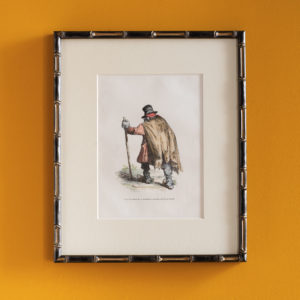
Public and Private Life of Animals, by J. J. Grandville, ‘Mendiant’,
£220 eachPublic and Private Life of Animals, by J. J. Grandville, ‘Mendiant’,
First published in France, these prints are based on the drawings of the famed caricaturist J. J. Grandville. Born Jean Ignace Isidore Gérard, Gradville; he fought on the barricades during the revolution of 1830 which dethroned Charles X, the last Bourban king. It was during this period that his cartoons appeared in two of the most famous satirical journals of the time; Le Charivari and Le Caricature, but in 1835 these publications were suppressed by the government of Louis-Philippe. This event extinguished his income and means of political expression and forced him to start making a living by book illustration. The ‘Public and Private Life of Animals’ allowed him to criticise society and its effect on individuals through one of the oldest narrative types; the animal fable. His caricaturist’s skills combined the human and animal characteristics giving him a vehicle of expression as to what was not permissible in ‘Society’ but was perfectly acceptable when the material was presented as humorous or satirical.£220 each -
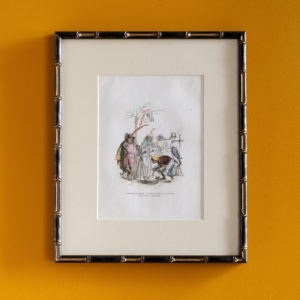
Public and Private Life of Animals, by J. J. Grandville,
£220 eachPublic and Private Life of Animals, by J. J. Grandville,
First published in France, these prints are based on the drawings of the famed caricaturist J. J. Grandville. Born Jean Ignace Isidore Gérard, Gradville; he fought on the barricades during the revolution of 1830 which dethroned Charles X, the last Bourban king. It was during this period that his cartoons appeared in two of the most famous satirical journals of the time; Le Charivari and Le Caricature, but in 1835 these publications were suppressed by the government of Louis-Philippe. This event extinguished his income and means of political expression and forced him to start making a living by book illustration. The ‘Public and Private Life of Animals’ allowed him to criticise society and its effect on individuals through one of the oldest narrative types; the animal fable. His caricaturist’s skills combined the human and animal characteristics giving him a vehicle of expression as to what was not permissible in ‘Society’ but was perfectly acceptable when the material was presented as humorous or satirical.£220 each -
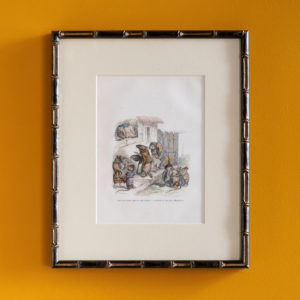
Public and Private Life of Animals, by J. J. Grandville, ‘La charite, s’il vous plait, Monseigneur’,
£220 eachPublic and Private Life of Animals, by J. J. Grandville, ‘La charite, s’il vous plait, Monseigneur’,
First published in France, these prints are based on the drawings of the famed caricaturist J. J. Grandville. Born Jean Ignace Isidore Gérard, Gradville; he fought on the barricades during the revolution of 1830 which dethroned Charles X, the last Bourban king. It was during this period that his cartoons appeared in two of the most famous satirical journals of the time; Le Charivari and Le Caricature, but in 1835 these publications were suppressed by the government of Louis-Philippe. This event extinguished his income and means of political expression and forced him to start making a living by book illustration. The ‘Public and Private Life of Animals’ allowed him to criticise society and its effect on individuals through one of the oldest narrative types; the animal fable. His caricaturist’s skills combined the human and animal characteristics giving him a vehicle of expression as to what was not permissible in ‘Society’ but was perfectly acceptable when the material was presented as humorous or satirical.£220 each -
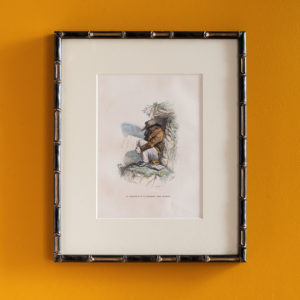
Public and Private Life of Animals, by J. J. Grandville, ‘Les occupations de ma vie contemplative’,
£220 eachPublic and Private Life of Animals, by J. J. Grandville, ‘Les occupations de ma vie contemplative’,
First published in France, these prints are based on the drawings of the famed caricaturist J. J. Grandville. Born Jean Ignace Isidore Gérard, Gradville; he fought on the barricades during the revolution of 1830 which dethroned Charles X, the last Bourban king. It was during this period that his cartoons appeared in two of the most famous satirical journals of the time; Le Charivari and Le Caricature, but in 1835 these publications were suppressed by the government of Louis-Philippe. This event extinguished his income and means of political expression and forced him to start making a living by book illustration. The ‘Public and Private Life of Animals’ allowed him to criticise society and its effect on individuals through one of the oldest narrative types; the animal fable. His caricaturist’s skills combined the human and animal characteristics giving him a vehicle of expression as to what was not permissible in ‘Society’ but was perfectly acceptable when the material was presented as humorous or satirical.£220 each -
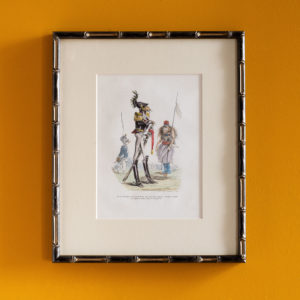
Public and Private Life of Animals, by J. J. Grandville, ‘la Sauterelle’,
£220 eachPublic and Private Life of Animals, by J. J. Grandville, ‘la Sauterelle’,
First published in France, these prints are based on the drawings of the famed caricaturist J. J. Grandville. Born Jean Ignace Isidore Gérard, Gradville; he fought on the barricades during the revolution of 1830 which dethroned Charles X, the last Bourban king. It was during this period that his cartoons appeared in two of the most famous satirical journals of the time; Le Charivari and Le Caricature, but in 1835 these publications were suppressed by the government of Louis-Philippe. This event extinguished his income and means of political expression and forced him to start making a living by book illustration. The ‘Public and Private Life of Animals’ allowed him to criticise society and its effect on individuals through one of the oldest narrative types; the animal fable. His caricaturist’s skills combined the human and animal characteristics giving him a vehicle of expression as to what was not permissible in ‘Society’ but was perfectly acceptable when the material was presented as humorous or satirical.£220 each -
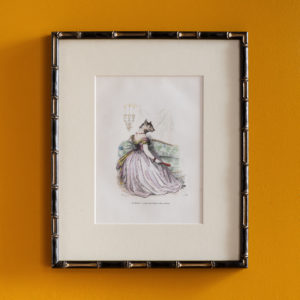
Public and Private Life of Animals, by J. J. Grandville, ‘la Louve mère de Rome’
£220 eachPublic and Private Life of Animals, by J. J. Grandville, ‘la Louve mère de Rome’
First published in France, these prints are based on the drawings of the famed caricaturist J. J. Grandville. Born Jean Ignace Isidore Gérard, Gradville; he fought on the barricades during the revolution of 1830 which dethroned Charles X, the last Bourban king. It was during this period that his cartoons appeared in two of the most famous satirical journals of the time; Le Charivari and Le Caricature, but in 1835 these publications were suppressed by the government of Louis-Philippe. This event extinguished his income and means of political expression and forced him to start making a living by book illustration. The ‘Public and Private Life of Animals’ allowed him to criticise society and its effect on individuals through one of the oldest narrative types; the animal fable. His caricaturist’s skills combined the human and animal characteristics giving him a vehicle of expression as to what was not permissible in ‘Society’ but was perfectly acceptable when the material was presented as humorous or satirical.£220 each -
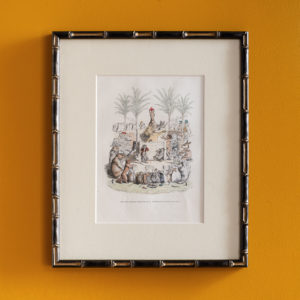
Public and Private Life of Animals, by J. J. Grandville, ‘ L’illustre orateur’,
£220 eachPublic and Private Life of Animals, by J. J. Grandville, ‘ L’illustre orateur’,
First published in France, these prints are based on the drawings of the famed caricaturist J. J. Grandville. Born Jean Ignace Isidore Gérard, Gradville; he fought on the barricades during the revolution of 1830 which dethroned Charles X, the last Bourban king. It was during this period that his cartoons appeared in two of the most famous satirical journals of the time; Le Charivari and Le Caricature, but in 1835 these publications were suppressed by the government of Louis-Philippe. This event extinguished his income and means of political expression and forced him to start making a living by book illustration. The ‘Public and Private Life of Animals’ allowed him to criticise society and its effect on individuals through one of the oldest narrative types; the animal fable. His caricaturist’s skills combined the human and animal characteristics giving him a vehicle of expression as to what was not permissible in ‘Society’ but was perfectly acceptable when the material was presented as humorous or satirical.£220 each -
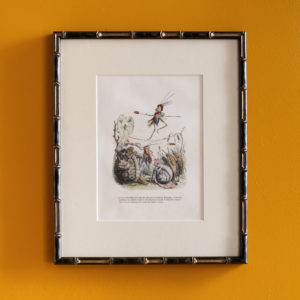
Public and Private Life of Animals, by J. J. Grandville, ‘ Le triomphant Criquet’,
£220 eachPublic and Private Life of Animals, by J. J. Grandville, ‘ Le triomphant Criquet’,
First published in France, these prints are based on the drawings of the famed caricaturist J. J. Grandville. Born Jean Ignace Isidore Gérard, Gradville; he fought on the barricades during the revolution of 1830 which dethroned Charles X, the last Bourban king. It was during this period that his cartoons appeared in two of the most famous satirical journals of the time; Le Charivari and Le Caricature, but in 1835 these publications were suppressed by the government of Louis-Philippe. This event extinguished his income and means of political expression and forced him to start making a living by book illustration. The ‘Public and Private Life of Animals’ allowed him to criticise society and its effect on individuals through one of the oldest narrative types; the animal fable. His caricaturist’s skills combined the human and animal characteristics giving him a vehicle of expression as to what was not permissible in ‘Society’ but was perfectly acceptable when the material was presented as humorous or satirical.£220 each
Featured Items
-
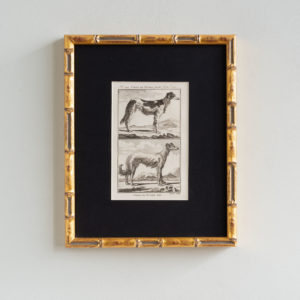
18th Century French Engravings of Dogs
£175 each18th Century French Engravings of Dogs
Published for, Histoire naturelle, générale et particulière (1749–1804), which was the first modern attempt to systematically present all existing knowledge in the fields of natural history, geology, and anthropology.£175 each -
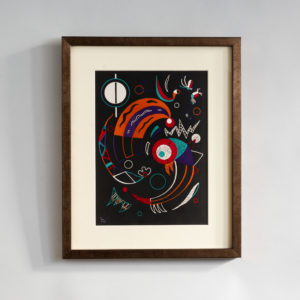
Comets by Wassily Kandinsky, Verve Vol. 1 / No. 2.
£800Comets by Wassily Kandinsky, Verve Vol. 1 / No. 2.
The Verve Review was a purposefully luxurious. It ran from 1937 to 1960, but with only 38 editions available, due to the high degree of design and editorial work dedicated to each issue. Each edition contained unique lithographic prints, commissioned by the editor, and each cover a double-page lithograph elaborated by one of the artists contained within. It was the brainchild of its editor Stratis Eleftheriades, a Greek National who moved to Paris in the early thirties to take part in the growing Modernist movement, writing under the name of Teriade.£800 -
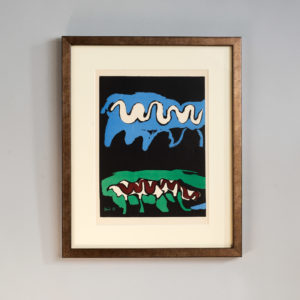
The Four Elements, Earth by Francisco Bores, Verve Vol. 1 / No. 1.
£600The Four Elements, Earth by Francisco Bores, Verve Vol. 1 / No. 1.
The Verve Review was a purposefully luxurious. It ran from 1937 to 1960, but with only 38 editions available, due to the high degree of design and editorial work dedicated to each issue. Each edition contained unique lithographic prints, commissioned by the editor, and each cover a double-page lithograph elaborated by one of the artists contained within. It was the brainchild of its editor Stratis Eleftheriades, a Greek National who moved to Paris in the early thirties to take part in the growing Modernist movement, writing under the name of Teriade.£600 -
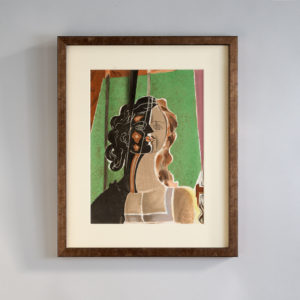
Figure by Georges Braque, Verve Vol 2 / No. 5-6.
£800Figure by Georges Braque, Verve Vol 2 / No. 5-6.
The Verve Review was a purposefully luxurious. It ran from 1937 to 1960, but with only 38 editions available, due to the high degree of design and editorial work dedicated to each issue. Each edition contained unique lithographic prints, commissioned by the editor, and each cover a double-page lithograph elaborated by one of the artists contained within. It was the brainchild of its editor Stratis Eleftheriades, a Greek National who moved to Paris in the early thirties to take part in the growing Modernist movement, writing under the name of Teriade.£800
